Share this with your friends:
Homesteaders, greenhouses, and backyard gardeners all enjoy starting seeds from their favorite plants in late winter and early spring. All have a common enemy – fungus gnats. Whether you have one houseplant or hundreds of starter plants for the garden, fungus gnats can destroy all the work you have put into the plants unless the pests are controlled. If you are also searching for home remedies for fungus gnats, you’ve come to the right place.
Fortunately, you can control these destructive pests organically with hydrogen peroxide. It’s an easy and inexpensive way to prevent these tiny insects from destroying your plants. Just one application of a hydrogen peroxide treatment will typically end the life cycle of fungus gnats. It’s a safe and effective control method that will not harm saplings, garden plants, or houseplants.
Read on to learn what fungus gnats are and how to get rid of them efficiently and inexpensively.
What Are Fungus Gnats?
Fungus gnats are small flies that infest the soil, potting mix, and any other types of organic growing mediums used in containers to start seeds or grow plants. These small flies will also infiltrate other organic decomposition sources, like compost and plant material, and lay eggs.
Fungus gnat larvae feed on fungi and organic matter in soil and other growing mediums as they develop into adult gnats. The larvae will also chew on the plant roots and create problems for any container-grown plants in greenhouses, nurseries, and inside your home.
How does Fungus Gnat look like?
Fungus gnats are often mistaken for mosquitos and fruit flies. Adults are tiny, less than 1/8-inch long, with thin legs, antennae longer than their head, and light gray or nearly transparent wings. Fungus Gnat Larvae have a shiny black head and a long legless body that is clear or white. They feed on organic mulch, leaf mold, grass clippings, compost, root hairs, and fungi commonly found in or on top of plant growing mediums.
Fungus Gnats vs. Fruit Flies
Many people mistakenly identify Fungus Gnats as Fruit flies. Both are annoying, flying creatures that fly around the house. But they are different in appearance and their preference for the living environment.
Fungus Gnats
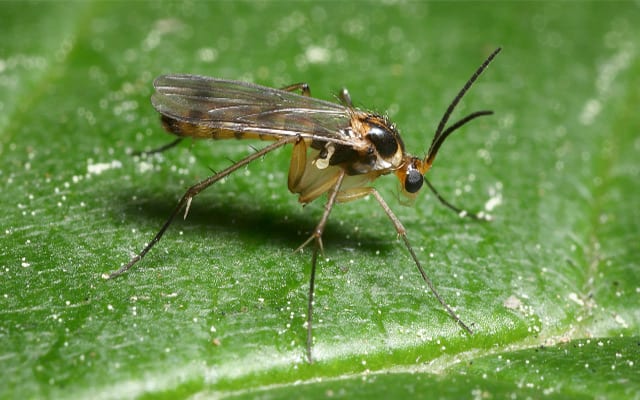
2. Attracted to a moist soil environment
3. Mostly found in seed starting pots, indoor plants and compost piles.
Fruit Flies
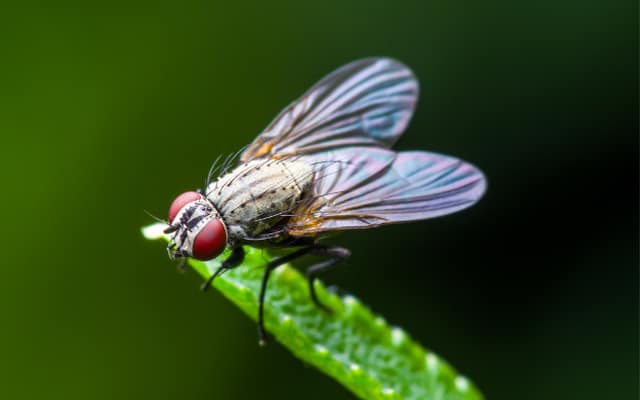
2. Attracted to decomposing or overripe produce and fruits
3. Mostly found near fruit bowls, kitchen sink, and garbage or trash cans.
How to identify Fungus Gnat infestation?
If the conditions of the growing medium or containers of organic matter are especially moist, or if there is a large infestation of fungus gnats, the larvae will leave slime trails on the surface of the growing medium that looks like trails from small snails or slugs.
Fungus gnats are attracted to light, and you may notice them flying around a lamp or window. These pests are weak fliers and never venture far from the soil they have infiltrated indoors.
They typically remain near potted plants. They can be observed running across or resting on top of the growing medium, plant foliage, compost, or wet mulch piles they have selected to call home.
Inspect plants at the nursery or garden supply center before purchasing them for any signs of pest infestation. If you bring home plants with fungus gnat larvae in the growing medium, it won’t be long before the larvae reach adulthood and lay more eggs in the potted plants you have at home.
How Fungus Gnats damage the plants
Adult fungus gnats don’t cause plant damage or threaten people or pets; they are an irritating nuisance. The larvae, however, can cause plant damage when present in large numbers. The larvae have a voracious appetite. After all the fungi and decomposing matter have been depleted from the growing medium, they will start chewing on the tender plant roots. The damaged roots can’t uptake nutrition and moisture for the plant. Thus the plant becomes stunted and cannot recover.
It is typically the case in seedlings and young plants. The infestation of fungus gnats larvae may not be noticeable until the young seedling is already damaged beyond repair. You may notice damage to an older potted plant before it reaches the point of no return. You can treat the soil with hydrogen peroxide to rid it of fungus gnats and larvae before it is too late.
Which Plants Are At Risk of Fungus Gnat damage
Vegetable plants, herbs, fruit plants, flowers, tree saplings, and houseplants are all subject to an attack from fungus gnats. The younger and more tender the plant is, like vegetable saplings started from seeds in the early spring, the more susceptible it is to a fungus gnat infestation.
These young plants typically have fresh, loose growing mediums that are easy for the fungus gnats to deposit their eggs into. The fresh growing medium is filled with the fungi and decomposing matter that the larvae need to feed upon. The looseness of the growing medium makes it easy for the larvae to wiggle around.
Females lay tiny eggs in moist growing mediums or organic debris so their larvae will have a rich food source as soon as the eggs hatch. Plants being grown in outdoor soil are rarely bothered by fungus gnats. It’s primarily the plants being grown in containers indoors at risk.
3 Hydrogen Peroxide Treatments to control Fungus Gnats
Most people have a bottle of hydrogen peroxide in their medicine cabinet at home. It’s a health and beauty product that has many uses and is very inexpensive. This foaming liquid is the most effective method to control fungus gnats, and it will not harm the plants or growing medium.
1. Hydrogen Peroxide to control Fungus Gnats on the indoor plants:
Step1: If an infestation is noticed, allow the top of the growing medium to dry out for a day or two before preparing the hydrogen peroxide treatment.
Step 2: Create a mixture of one part hydrogen peroxide and four parts water.
Step 3: Use this mixture to water the infested plant just like you usually would. Pour it onto the growing medium of every plant that has or potentially could have fungus gnats or their larvae.
The hydrogen peroxide and water mixture will foam and fizz a little when it comes into contact with the growing medium, but that is normal. It will kill fungus gnat larvae on contact. After a few minutes, the fizzing will stop, and the hydrogen peroxide breaks down into harmless oxygen and water molecules.
2. Hydrogen Peroxide Spray to control flying Fungus Gnats
Adult fungus gnats may be observed flying around the plant after the initial treatment. They will need to be disposed of before they can lay more eggs in the growing medium.
Step 1: Mix one part of hydrogen peroxide and four parts of water in a spray bottle.
Step 2: Lightly spray the plant leaves and stems where the adult fungus gnats are visible.
Step 3: Repeat as needed until the adults are no longer visible.
TIP: Hold a newspaper or similar item on the opposite side of the plant while applying the spray treatment to prevent it from landing on furniture or flooring.
In addition to this treatment, you can put Fungus Gnat traps near the base of the plant to trap the flying adult fungus gnats.
3. Hydrogen Peroxide Soil Drench for heavy infestation
If the infestation of fungus gnat is severe, you need to get rid of the baby gnats in soil (Fungus gnat larvae) or the growing medium along with the flying gnats. To make this indoor plant gnat killer:
Step 1: Stop watering the plant. Allow the growing medium to dry out slightly.
Step 2: Move the potted plant to the sink or outside so it can be drenched with the hydrogen peroxide treatment.
Step 3: Mix one part of hydrogen peroxide and four parts of water in a container.
Step 4: Saturate the potting soil with the hydrogen peroxide and water mixture until it freely runs out of the container’s bottom drainage holes.
Step 5: Wait for 10 minutes and repeat the step above once again.
This process will instantly kill the larvae and help flush the tiny dead carcasses out of the growing medium.
As a bonus, this flushing with hydrogen peroxide and water will remove any excess salt build-up in the growing medium caused by over-fertilizing the plant.
You may also wish to alternate Hydrogen Peroxide treatment with Neem Oil insecticide spray for maximum effectiveness in controlling fungus gnats.
How to prevent Fungus Gnat infestation from re-occurring
The treatment can be repeated as needed, but it typically only requires one treatment to rid the growing medium of larvae.
- After applying the hydrogen peroxide treatment above, help prevent future infestation by reducing the amount of water given to the plants.
- Fungus gnats thrive in moist, warm environments that are needed to promote seed germination and seedling development. Slightly reducing the amount of water given to the plant will make the growing medium a less inviting environment for the fungus gnat to thrive in.
- If the infestation is located in an outdoor compost or manure pile, treat the infestation with the hydrogen peroxide mixture until it’s saturated. Then let the pile dry out and stay as dry as possible.
- To prevent the gnats from being attracted to your potted plants by keeping the compost bin, manure pile, and other organic debris away from the greenhouse, container garden, house, or any other location where potted plants are grown.
- Don’t feed plants with excessive amounts of manure, blood meal, or similar organic materials that attract fungus gnats.
- Prevent the pests from coming indoors by keeping the doors and windows closed and sealing any cracks or tears in the screens or windows.
Related questions:
Life Cycle of Fungus Gnat
Fungus gnat life cycle has four stages -egg, larvae, pupa, and adult. The majority of its life is spent in the larvae and pupa stages. In 17 days, the eggs are laid in the growing medium, and the adults emerge ready to lay more eggs.
Fungus gnats can reproduce multiple times throughout the course of one year. The vast number of these destructive garden pests produce and reproduce if left uncontrolled. Their innumerable and destructive capabilities to plants are irreparable.
Where do fungus gnats come from?
Fungus gnats come into the house through open doors or windows. They may also come along with an infested potted plant. If you move outdoor potted plants inside for winter storage (like your potted Curry Leaf Plant), you may inadvertently bring in Fungus Gnat and their larvae into your home as well.
Is hydrogen peroxide organic or natural?
The chemical composition of the Hydrogen Peroxide molecule is H2O2. That means an extra oxygen molecule is joined to a water molecule. Although Hydrogen Peroxide sold in the stores is manufactured by chemical processes, Hydrogen Peroxide can occur naturally by sunlight reacting with water or as a byproduct of animal and plant bioprocesses.
In a small amount, it is safe to use Hydrogen Peroxide for plants in organic gardening. But do keep in mind that it can act as a bleaching agent and strip away organic components from the soil when used excessively.
Conclusion:
Daily observation and a little hydrogen peroxide can stop the damage caused by these pests before it can even get started. It’s incredible how you can control such a potentially harmful garden pest with an inexpensive and straightforward treatment of hydrogen peroxide. Hopefully, you won’t need to suffer these annoying creatures when you start your seeds indoors!
Have you tried this treatment in your home? Have any other ideas to get rid of Fungus Gnats? Please do share your thoughts with me by writing a comment below.
If you find this information helpful, don’t keep it to yourself! Share the link to this article on your Facebook page or gardening group. Your fellow gardeners will thank you for it!
Pin this post for a visual reminder
Would you like to refer to this article frequently? Just pin this image to one of your Pinterest gardening boards so that you can easily find it later when you need it.
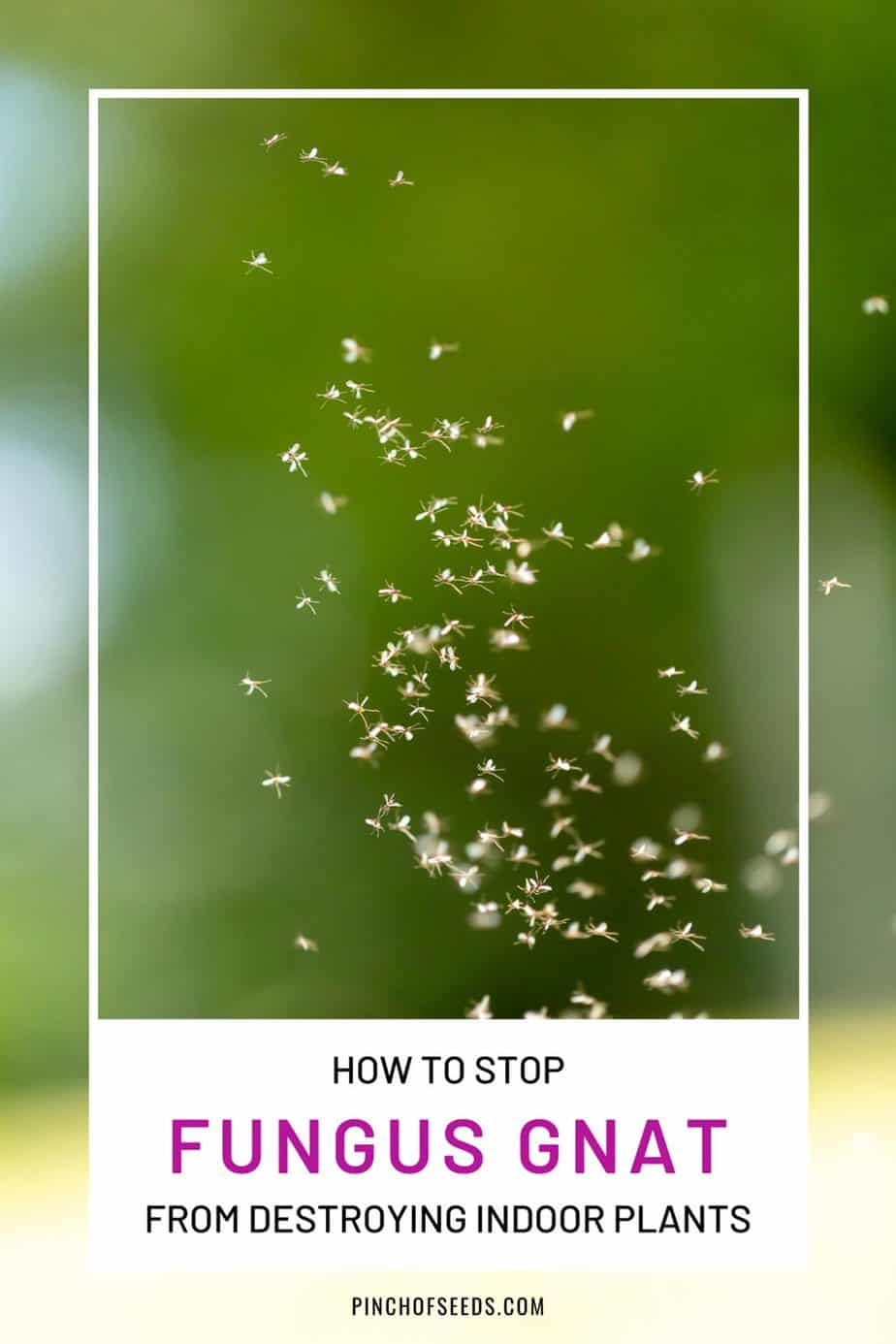
Share this with your friends:
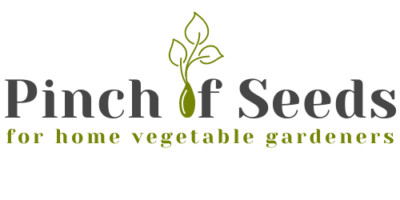
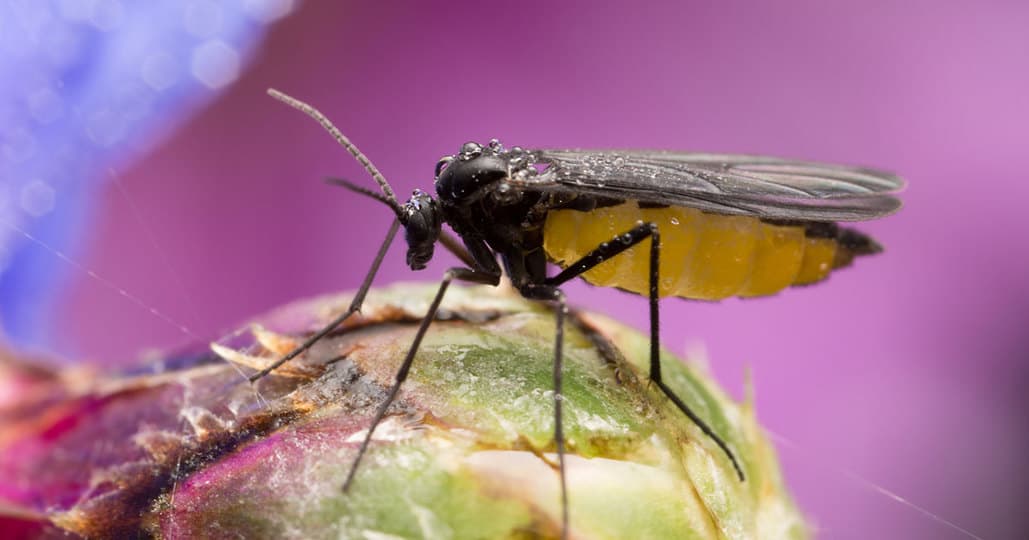
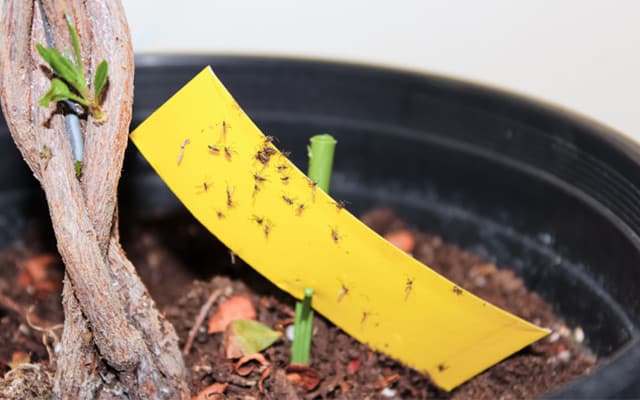
Hello Gopi,
Thanks for the article.
A couple of things.
Hydrogen peroxide can be purchased at different concentrations: it is important to let people know what concentration you have been using, that you then further dilute with 1 part H202, 4 parts H2O.
You mentioned that hydrogen peroxide will not harm the growing medium. Although the benefit of getting rid of the fungus gnats outweighs the damage, hydrogen peroxide will kill beneficial soil bacteria which can provide protection and nutrients for the plant roots.
Happy gardening!
I can’t find where you state what strength peroxide you start with before dilution.
Use 3% H202 and mix 4:1 (4 parts water). -Greg
I had an infestation of gnats after re potting a large cacti. I think the potting soil was infested. Anyway, I used a nematode treatment which greatly reduced the amount of gnats but did not rid my cactus of them. Continued with yellow sticky traps and then tried Misquote Dunks tea. Gnats remain so I will now try repotting but before I do I will hose down my cactus roots then once repotted I will drench with hydrogen peroxide 3% solution in water then finish off the top soil with 3cm of crushed shells. That way the gnats can’t climb up or back down and the shells won’t hold moisture for them to thrive. Hopefully this will work!
Hi Gopi,
I notice that people are saying that gnats are attracted to light however when I turn on my grow light they disappear !!! is it possible that what I see in the soil are not fungus gnats? and if not, what other pests can they be? I spray the soil with Neem oil mix but it seems that doesn’t work. I may have to try the hydrogen peroxide.
In 2018 I had a horrible fungus gnat infestation in all of my plants. I tried mosquito dunks with yellow plant stickies (to control adults), and the dunks merely controlled the gnats but did not get rid of them. I did not know about the peroxide at the time, and used an insecticide meant for killing a broad spectrum of critters in plants (.22% imidacloprid insecticide, branded as “Bondide (BND951 – Systemic House Plant Insect Control). It worked extremely well. One treatment of all plants and the gnats were gone. Obviously this isn’t option for veggies or plants that pets nibble on. Another method I previously used that worked well was rinsing ALL of my plant roots in water thoroughly, baking the infected soil in disposable foil pans at 180 degrees for several hours, re-potting them, and then moving them to my office for several weeks to ensure any adults flying around my home died. That also worked well but was quite a lot of work.
Okay so i was soooo excited to have a solution that after reading your post and the comments i was reasonably confident was going to work. I bought a ridiculous amount of peroxide spent half an hour dragging all of my houseplants outside and then used the soil drench method (we have so many gnats its embarrassing) as well as spraying the flying ones. Is the point of spraying them to drown them because the mixture of peroxide and water seems to have little or no effect at all on the adult gnats. Please and i am begging here tell me what i can do to get rid of these nasty things. (I followed the instructions EXACTLY)
Hi Kimberly,
I have been through the embarrassing situation of gnat problem myself, so I know how you feel! The problem with gnats is they multiply so fast that we need to tackle both adults as well as the larvae in the soil to completely disrupt their breeding cycle. The most effective way would be to spray down the leaves (using the yellow sticky pads help capture the adult gnats) as well as drench the soil, and repeat that several times to completely get rid of them.
When weather gets better, leaving the indoor plants outside for a few days also helps. The natural predators of gnats will feast on them and accelerates the control process.
Hope this helps! Good luck!
-Gopi
Potting Soil and Coco coir are organic material. Mold and Fungus spores are always in the air. Hydrogen peroxide reduces bacterial growth that’s why it is used for cleaning cuts and wounds also.
Overwatering, poor ventilation and lack of adequate sun is the main cause that the mold, mildew and fungus take hold easily. This is the reason why mold and mildew develop in dark bathroom that are humid and poorly ventilated.
To get rid of the gnats and fungus, stop watering till the top layer becomes completely dry. Remove up to 1/2 inch of soil around the plant – hopefully this will remove all the spores and eggs. Replace with new soil and follow Gopi’s recommendation.
Tips To Healthy Plants
Do not overwater: Too much water may drown the roots when drain hole is not available and when drainage is available, you may wash away the nutrients from the soil.
Nutrients: For healthy plants, please add the exact amount of nutrients recommended for your particular plant. If you are doing Organic gardening blend with compost and topsoil.
Sunlight: Different plants need different amounts of sunlight and temperature – please make sure to provide the right amount of sunlight and good ventilation at the right temperature.
Hope this helps.
Thank you for your wonderful suggestions Nathan!
Great info — thank you! I cannot seem to get rid of the fungus gnats. I have 13 plants in a small apartment in New York City and I don’t know if I should get rid of them or what to do because I just can’t get rid of the gnats. Do you know anything about mosquito dunks and if those might work? Thank you!
I grab my hand held vacuum after treating my plants with peroxide! Vacuum those gnats up!
Thanks for a great article. Just above the conclusions, there is something that appears to be in a different language. What does “Lorem ipsum dolor sit amet, consectetur adipiscing elit. Ut elit tellus, luctus nec ullamcorper mattis, pulvinar dapibus leo.” mean?
Oops! That was a typo! Thank you for pointing it out!
– Gopi
Hi Gopi!
Thank you for this very useful and effective article.
When dealing with a heavy infestation – waiting for the adult gnats to disappear – how often and how many times can I water my potted plants with the hydrogen peroxide solution? I have done so once. But I’ve noticed gnats skipping on the soil of certain plants, and worse, on the soil of my seedlings trays.
Thank you for your help,
Chloe
I have this same question. So far, I’ve done two hydrogen peroxide flushes on my houseplants, but the gnats persist. Is it bad for my plants to repeat it weekly until the gnats are gone? I have a ton of yellow sticky traps , which tend to be covered in adult gnats (gross). And I’ve cut back on watering significantly, only watering when the moisture meter shows that they are dry (and am watering with mosquito bit tea only).
I have too many great plants to toss them and start over, but these gnats are making me insane. Please help.
Hello Gopi!
I’m a huge home gardening enthusiast and passionate about advancing this industry. I ran into your site when looking for some tips on starting a new curry leaf plant from cuttings. I have to say your site is extremely well organized and very informative for beginners like me.
I’m a product management professional and work very closely with Technology entreprenuers. I am interested in advancing the customer and marketing experience in the Gardening industry. Wanted to check if you would be interested in talking about this given your background (contact email provided).
Thanks!